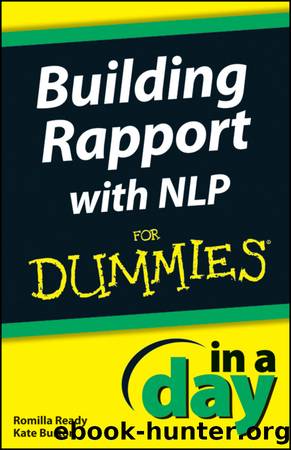Building Rapport with NLP In a Day For Dummies by Romilla Ready

Author:Romilla Ready
Language: eng
Format: epub
Publisher: Wiley
Published: 2012-05-21T00:00:00+00:00
Have you ever heard a dispute that goes something like the following one between a manager and a team member in the office? To demonstrate the different language styles, we show the predicates (the sensory-specific words and expressions) in italics:
Manager: (Betty) âI canât see your point of view about your appraisalâ (visual).
Employee: (Bill) âWell, can we talk about it further?â (auditory).
Betty: âItâs perfectly clear to me â just black and whiteâ (visual).
Bill: âIf youâd discuss it, it may be more harmonious around hereâ (auditory).
Betty: âJust have a closer look. Iâm sure youâll get a better perspectiveâ (visual).
Bill: âYou never listen, do you? End of conversationâ (auditory).
Betty, the manager, stays with visual language, and the employee, Bill, is stuck in auditory mode: theyâre disconnected and not making progress.
Hereâs how a third person â maybe Bob from human resources or another department â can help to shift the dispute:
1. Bob sums up the situation in visual mode to Betty and auditory mode to Bill. The conversation goes something like:
âSo, Betty, it looks like you have a clear picture of the situation (visual). And Bill, youâve still got some important questions to talk through (auditory).â (Heads nod in agreement.)
2. Then Bob shifts into the third system (kinaesthetic), which is neutral ground for both arguing parties.
âYou both want to get this moving and off the agenda. So how about we all kick around the stumbling blocks for an hour in my office, reshape the problem and finally put it to bed.â
One of our colleagues, Helen, was a touch sceptical about the language differences when she first became curious about NLP. Yet she experienced one of those wonderful light-bulb moments when she first discovered her own representational systems and decided to play with them at home before trying them out in her business life. She noticed how her husband, Peter, sometimes switched off and seemed uninterested when she wanted to talk about important decisions at home. She wondered whether changing the words she used would have any effect.
Helen says: âIâd be ready to talk to him about pretty major issues such as which schools the girls should go to or whether we should go ahead and spend thousands of pounds on redesigning the kitchen, and all Iâd get was a cursory âYup, fineâ or âNo, not now.â I realised that having a strong kinaesthetic preference, I often began a conversation with: âPeter, how do you feel about XYZ?â I also noticed that he used plenty of visual language. So I thought Iâd give it a go and ask him: âPeter, how do you see XYZ?â The difference, when I began playing with it and slipping more visual words into the conversation, was quite staggering. The change was so easy to make and, hey presto, I got his attention. It was almost magical!â
NLP suggests that everyone has the capacity to develop their sensory representational systems, by simply moving their bodies or turning off the mobile phone to see whatâs going on around them.
As with any system, making a
Download
This site does not store any files on its server. We only index and link to content provided by other sites. Please contact the content providers to delete copyright contents if any and email us, we'll remove relevant links or contents immediately.
Foolproof Persuasion: The Visual Guide To Influencing Others Without Ever Being Wrong by Vinh Ly(1286)
Beliefs by Robert Dilts(1189)
Free Yourself from Fears by Joseph O'Connor(1183)
Neuro-linguistic Programming for Dummies by Romilla Ready & Kate Burton(1155)
Moneyball by Michael Lewis(1118)
NLP by Tom Hoobyar(1048)
Moneyball: The Art of Winning an Unfair Game by Michael Lewis(1033)
NLP For Parents by Judy Bartkowiak(998)
Mind Control Hypnosis by Dantalion Jones(955)
Dark NLP: How To Use Neuro-linguistic Programming For Self Mastery, Getting What You Want, Mastering Others And To Gain An Advantage Over Anyone by Pace Michael(946)
Neurolinguistic Programming (NLP) by Neil Shah(938)
Get Laid or Die Trying by Jeff Allen(937)
The Happiness Habit by Brian Colbert(928)
Forward: A Memoir by Abby Wambach(924)
Breaking Up with Busy by Yvonne Tally(917)
Well Designed Life: 10 Lessons in Brain Science & Design Thinking for a Mindful, Healthy, & Purposeful Life by Bobinet MD MPH Kyra(877)
Psychology: How To Effortlessly Attract, Manipulate And Read Anyone Unknowingly - Become A Master Persuader INSTANTLY by Steel Jack(853)
Transformational NLP by Carl Buchheit Ellie Schamber(830)
The PPD Learning NLP Practice Group Book: The Special Guest Sessions by Judith Lowe(786)
